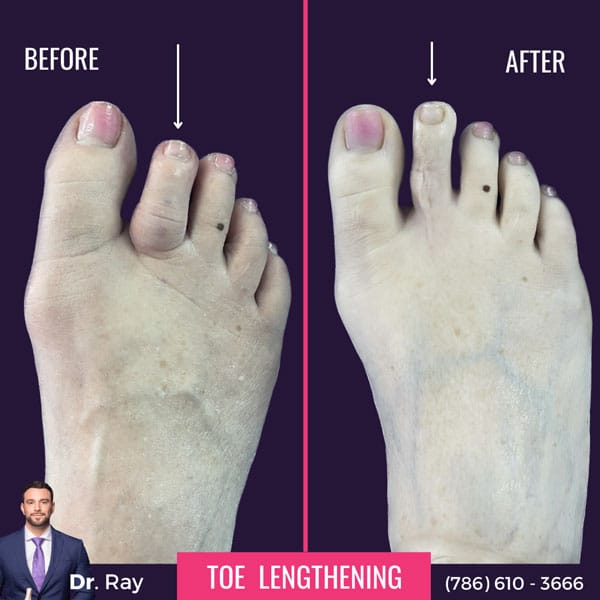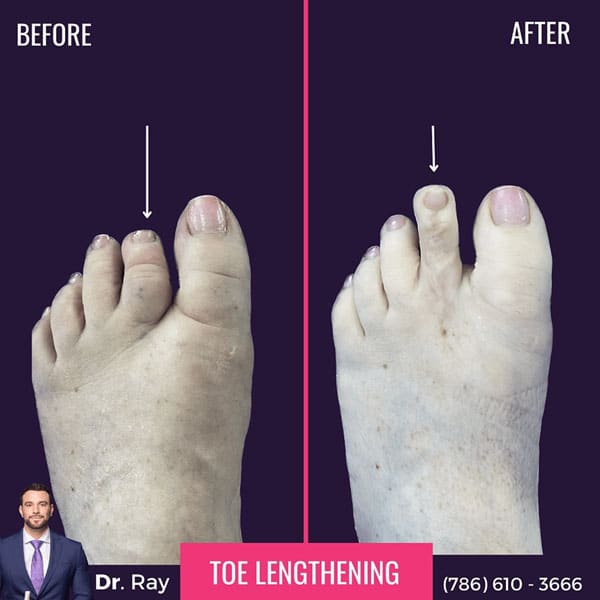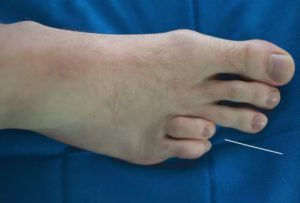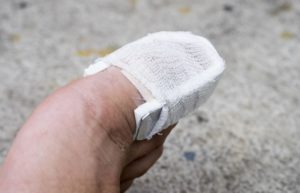Toe Lengthening Surgery
If you have a short toe and experience some symptoms related to this deformity, the idea of the toe lengthening surgery has probably crossed your mind once or twice. When you finally decide to go for it, the first step you should take is researching the procedure – what can you expect from this surgery and its recovery time? Will the results be satisfactory enough to go through all that trouble? We’ve answered all questions on this topic in this text.
AVERAGE COST
$3,000 per toe
PROCEDURE TIME
25 – 40 Min
BACK TO WORK
1 week
FULL RECOVERY
5 weeks
Book Your Free Consultation
Toe Lengthening Surgery Before and After


How Will the Surgeon Fix Your Short Toe? Here’s What the Procedure Is Like
Toe lengthening surgery is a simple outpatient procedure – which means you will be home the same day after the surgery.
You won’t feel any pain while the surgeon does their job thanks to anesthesia – in most cases, local anesthesia is enough to relieve the pain during surgery.
Still, sometimes it’s necessary to put patients under regional, spinal, or general anesthesia, but these cases are rare. There are many techniques that can be used to lengthen the toe, but only three are regularly used today. Let’s go over all three types of procedures in the following text.
Brachymetatarsia external fixator lengthening
This is a popular procedure that can allow the gaining of any amount of length that the patient needs. The principle is basically stretching the bone. The surgeon makes a small but very precise incision in the metatarsal bone (metatarsal corticotomy) in a way that will preserve blood flow completely.
Then, the small external fixator is attached to the segments of the metatarsal – this is used to stretch the bone over time. The patient will have to turn the device four times a day. This will help the bone and surrounding soft tissues to stretch. When the desired length is achieved, and the bone is fully healed, the fixator is removed.
Bone-graft lengthening
As the name suggests, this technique involves using a graft, usually from a patient’s heel bone. The graft is placed into the short metatarsal bone.
Still, there is a limit to this procedure – it can only be used if the surgeon needs less than one centimeter of lengthening and when there is just one short toe and one metatarsal bone to lengthen. Of course, the graft needs to be stabilized by metal screws and plates that will stay in the foot.
Sliding bone-cut lengthening
This technique is the least common out of the three because it allows for minimal changes in the toe length. That’s why it’s only used in mild cases where small change is exactly what’s needed.
The surgeon makes an angulated incision on the metatarsal bone, and sliding of the bones allows for lengthening. To keep everything in place, the surgeon uses metal plates or screws.
What Are the Benefits of the Procedure?
In addition to excellent results and the appearance of the feet that you’ve always wanted, the benefits of this surgery include better balance and weight-bearing, minimal risks, and quick recovery. The procedure is quick – it usually takes about 60 minutes.
You don’t feel any pain while the surgeon does their job, and the techniques used to get you a longer toe are simple, with little to no complications.
What Are the Symptoms of a Short Toe?
The short toe doesn’t necessarily have to be a problem that drives you to visit a podiatrist, but it often is. The most common issue related to this deformity is pain during standing, walking, or performing other activities. The reason for this lies in the fact that the balance of the foot and weight distribution are affected – especially if the short toe doesn’t even touch the ground.
When the toe is elevated, wearing certain shoes can be an issue – the toe is facing upwards, which means that it is rubbing against the shoe. Pressure and friction can, over time, cause the development of corns and calluses. They are both problems on their own – corn removal surgery is a whole different topic. Needless to say, corns and calluses are unpleasant complications that anyone would prefer to avoid.
Another important aspect of having a short toe isn’t medical, but its significance shouldn’t be overlooked. We’re talking about aesthetics. While appearance surely isn’t as important as medical symptoms, it still is a real problem for those who have a short toe. This deformity is often a source of discomfort and embarrassment. Patients often avoid open shoes and going barefoot, or even beaches. Correction of the short toe often has a huge impact on the quality of life.
What Causes It?
Brachymetatarsia is a hereditary condition that more commonly affects women than men. In a small number of cases, trauma can play a significant role in the development of this deformity (usually when there is an injury to the growth plate). It’s important to note that this isn’t a birth defect but a problem with bone growth. A short toe can appear on one or both feet and sometimes can even occur on the hand.
It can also be found in people with Down syndrome or those who have pseudohypoparathyroidism. While it is true that usually, just one metatarsal bone is shorter than others, it is possible to have more than one metatarsal affected – which leads to more than one short toe (then the condition is called brachymetapody). However, this is quite a rare case.
When to Seek Treatment for a Short Toe?
How do you know it is the right time to seek treatment? First and foremost, if you’re experiencing any level of pain (located in the ball of the foot), there’s no reason to put up with it – reach out to your doctor and get a consultation to find out more about the surgery. Of course, pain isn’t the only significant problem – discomfort while walking, weight-bearing, or during any activities is also a sign to get medical help. You might also notice that the deformity is worsening over time or that your regular shoes can no longer fit due to the toe elevation.
In some cases, there may be none of these symptoms, but the short toe will still be a cosmetic problem. Can you treat it simply because of its looks? Of course, you can – medical advancements have gone so far that this won’t be a complicated procedure, so the result will be well worth the (minimal) trouble you go through. Minimally invasive foot surgeries for aesthetic reasons are quite common these days.
Who Is a Good Candidate for Toe Lengthening Surgery?
Just like toe shortening surgery, this one doesn’t have any requirements for the patient. Everyone who has a short toe and doesn’t like it can be a good candidate – you just have to make the decision and seek the best specialists for this kind of procedure in your area. We should note that having a short toe isn’t the only indication for toe lengthening surgery. If you have previously had minimally invasive hammertoe surgery and your toe was shortened more than you’d like, you could also benefit from a toe lengthening procedure. A skilled surgeon will know how to fix the mistake from your previous surgery.
How Does Toe Lengthening Surgery Help You?
You might ask yourself – is surgery really the only way to fix this deformity? Maybe you’re worried about undergoing the procedure, and you’d prefer to avoid it if possible – is there any other way? Sadly, no – surgeries are a way to go when it comes to almost every foot deformity. Non-surgical treatments do exist, but they can’t do much in the long run. They are barely able to help with the symptoms but will not fix the toe deformation itself.
Things that can help include over-the-counter anti-inflammatory medications, splints, pads, and custom-made foot orthotics designed to support the foot. Your doctor might recommend some of the options mentioned above, but this will probably just be a way to control the condition while you get ready for the surgery.
So, at the end of the day, surgery is the only permanent solution for your toe problems. The good news is that the toe lengthening procedure is quick and straightforward and doesn’t have complications in most cases. It’s safe to say that this surgery will help you a lot in terms of pain and quality of life. You will be able to walk effortlessly, participate in sports, and wear any shoes you like – isn’t that worth a short discomfort during the recovery period? We’d say it is.
How Much Does Toe Lengthening Surgery Cost?
How much is the toe lengthening surgery cost exactly? Of course, the price will vary on a few factors, such as the experience and skill of your surgeon, the complexity of the case, and even the state where you’re having the procedure.
On average, this procedure costs around $10,000. It can be more, but it can be less, as it all depends on each individual case.
You should be prepared for the possibility that your medical insurance won’t cover toe lengthening, even when it’s medically necessary. If we’re talking about a strictly cosmetic procedure, you surely won’t be compensated for it. If you have more than one toe fixed, the price will be higher, logically.
What Is Toe Lengthening Surgery Recovery Time?
Even the simplest surgeries require a certain period of recovery. If you plan on undergoing this particular procedure, you must be wondering about toe lengthening surgery recovery time. The period of time you will need in order to fully heal depends on the type of procedure you had (out of the three techniques listed above). Generally speaking, you will need at least six to eight weeks to recover – this is the period you will have to stay off your feet. Returning to physical activity depends on post-operative pain, swelling, and incision sensitivity.
If you had a large defect that required placing an external fixator, there might be casting involved – for up to three months. When three months are up, you will have to wear a special lace-up shoe for another six weeks. There are some factors that may prolong your healing time – smoking (slows down the healing of the tissue), poor nutrition, age, and certain medical problems. It’s important to note that sutures are usually removed two weeks after the surgery.
We’ve mentioned that you won’t experience pain during the procedure, but you might feel it after – once the anesthesia wears off. Usually, the pain isn’t severe enough to cause patients great discomfort, but it depends from case to case. Some patients won’t even need pain medication, but some definitely will.
If you experience pain after the toe lengthening procedure, your doctor will prescribe medication to help with that – in most cases, it would be one of the NSAIDs (most commonly used, over-the-counter pain medications). Another thing that can help with discomfort is using ice packs – but be sure never to place the ice directly on the skin. Use a thin cloth between ice and skin.
Are There Some Risks That Come With Toe Lengthening Surgery?
While there aren’t any downsides to toe lengthening procedures, it would be false to claim that there aren’t any risks associated with these surgeries. Keep in mind that every surgery poses some level of risk to the patient, even minimally invasive ones. After all, it requires a certain trauma to the tissue – both soft and bone in this case.
So, it’s to be expected that some complications may occur. However, remember that they are rare for this sort of procedure and that most patients recover fully with no problems. Complications can be related to the use of anesthesia, which isn’t necessarily a medical mistake. Here are other issues that may occur as a result of the toe lengthening procedures:
- Infection of the surgical site,
- Stiffness and weakness of the toe,
- Swelling,
- Bleeding,
- Blood clots,
- Wound dehiscence (poor wound healing),
- Malunion or nonunion,
- Delayed union,
- Nerve damage,
- Complications related to surgical hardware,
- Temporary or permanent pain,
- Need for additional surgery.
Consult With Your Surgeon
Deciding to undergo any surgery is a huge step – we know that. That’s why you need to make sure you have a good team of experts by your side who will do everything it takes to help you achieve the best possible health. If you’re getting ready to search for toe lengthening surgery near me – don’t bother since you’ve already found us to help with your foot deformity. Luxe Foot Surgery clinic is here for you – we would be delighted to have you as our patient.
Before we schedule your operation, you will have to come in for a consultation with our doctor. He will do a physical examination to check your foot and overall health condition – this is the important step towards your foot surgery. You can rest assured that if you entrust us with your health, you will be in the best hands possible. Our team consists of skilled and experienced surgeon who is considered expert in his fields and is committed to providing the best treatment to each and every patient.
So, what are you waiting for? Contact us today to schedule your first appointment. You can reach out via an inquiry form on our website, or you can call our office – Monday to Thursday from 9 AM – 6 PM and Friday from 9 AM – 5 PM. We are looking forward to meeting you and helping you with your foot condition.
Frequently asked questions
As the name suggests, a short toe is a type of deformity where one of the toes appears shorter than the others. This condition can affect any toe, but it is most commonly found on the fourth toe. Medically speaking, this is called brachymetatarsia. The problem isn’t the toe itself, however. Brachymetatarsia refers to a disruption of growth in the metatarsal bone – this is the bone that the toe is attached to in the arch of the foot.
So, the toe itself is correctly developed and has a normal length, but the bone attached to it doesn’t, which causes the toe to appear shorter than the rest of the toes. In most cases, other metatarsal bones are developed normally. If the affected toe looks really short, it can even be described as a floating toe.
Yes, toe lengthening surgery is quite possible, and it’s actually a standard and simple procedure that can be performed for medical or cosmetic reasons. Depending on the severity of the deformity, toe lengthening can be done with these techniques – placing an external fixator, placing a bone graft, or making a sliding bone cut.
This surgery is an outpatient procedure that takes about 60 minutes, after which you can immediately go home. The recovery period is usually six to eight weeks, but for severe cases, it can take up to three months to fully recover.
Weight-bearing and walking after toe lengthening surgery depend on the type of procedure that was performed and the amount of lengthening that was required. However, in most cases, you won’t be able to walk after this surgery. It will take you about six to eight weeks to get back on your feet – if the deformity was complex, it might be even longer. Worst case scenario, you won’t be back to walking until three months after the procedure.
Walking also depends on the level of pain and swelling that a patient might experience during recovery time.
You can get surgery to make your toes longer. Toe lengthening surgery is a common procedure nowadays, and it can be done for medical and aesthetic purposes. It’s a quick outpatient procedure that’s usually done under local anesthesia, and it has a fairly short recovery period (six to eight weeks in most cases or up to three months in severe cases).
Toe lengthening can be done with one of the following techniques – sliding bone-cut lengthening, bone-graft lengthening, and brachymetatarsia external fixator lengthening.
Yes, surgical hardware is an essential part of these procedures. Depending on which technique was used to fix the deformity, hardware can be permanent or temporal. When there is an external fixator involved, for example, the rods that are used to hold the bone in place are removed once the bone is lengthened and fully healed.
On the other hand, screws and plates that are used for bone grafting are permanent (the patient might request to remove them in the future, however).
There is always a possibility of complications related to anesthesia use, which may or may not be a medical mistake. While most complications after this procedure are rare, it’s still important to know what to expect. Conditions that may occur as a result of the toe lengthening surgery include infection of the incision site, pain, bleeding, swelling/stiffness/weakness of the foot, poor wound healing, poor bone healing, issues with hardware use, nerve damage, and need for revisional surgery team
Latest Articles

Toe lengthening surgery before and after
Toe lengthening surgery, also known as toe augmentation or toe shortening surgery, is a procedure aimed at altering the length

Metatarsal lengthening surgery
Metatarsal lengthening surgery is a procedure performed to address conditions such as metatarsalgia or a shortened metatarsal bone. It involves

Toe Lengthening Surgery in New York and Miami
Toe lengthening surgery is a procedure designed to increase the length of one or more toes and improve their appearance

Toe Lengthening and Prosthetic Nail Surgery
Toe lengthening and prosthetic nail surgery are two types of foot surgeries that can be used to address a variety

Does Toe Lengthening Surgery Hurt
Before every medical procedure, the patients usually create a pros and cons list in their heads to weigh out if

Walking After Toe Lengthening Surgery
Most people that are unsatisfied with their toes think about toe lengthening surgery at some point. The first thing that

Toe Lengthening Without Surgery
If you are struggling with brachymetatarsia, otherwise known as a short toe, you must be wondering – is toe lengthening

Toe Lengthening Surgery Recovery Time
Brachymetatarsia, otherwise known as a short toe, is a foot condition caused by stunted growth of one of the metatarsal

Toe Lengthening Procedure
The toe lengthening procedure, also known as toe augmentation or toe extension, is a type of surgical procedure that aims

Heel Cord Lengthening Surgery for Toe Walking
Toe walking is a condition that can occur in some children. It can be idiopathic or due to an underlying

Toe Extensor Tendon Lengthening CPT
If you’ve been experiencing chronic pain and having trouble with walking and the appearance of your feet because of your

Heel Cord Lengthening and Toe Pins – What You Should Know
Heel cord lengthening and toe pins, also known as the Achilles tendon lengthening surgery, is a medical procedure where, as